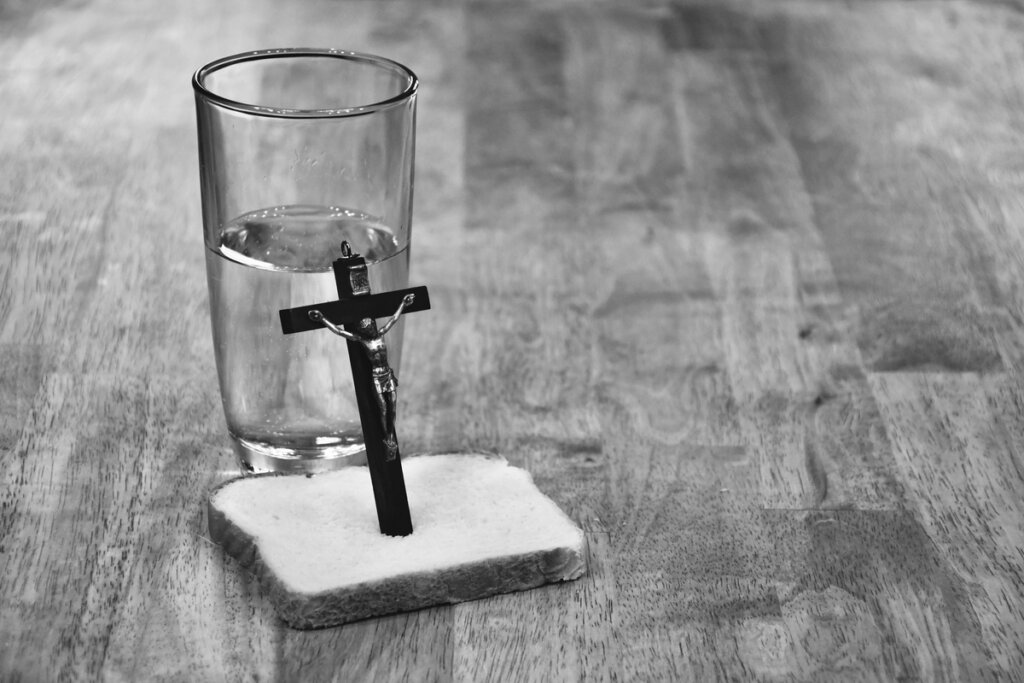
Don’t blink. Lent will be here before you know it. In fact, Ash Wednesday is early this year: February 17th.
Isn’t that how it always is? The Christmas season is behind us and it feels like Ordinary Time has only just begun—
But suddenly it’s Ash Wednesday, and we’re scrambling to decide what we’re doing for Lent and wondering whether our choice of penance is too hard or too easy.
This year, don’t let Lent take you by surprise—have your Lenten plan in place.
Here’s how.
How to Make a Plan for Lent

Before Ash Wednesday catches you unawares, make a point of sitting down—at the kitchen table, or at the chapel—and give some thought to how you want to spend this Lent.
If you have no idea where to begin, rest assured: there is a solid foundation to work from. The Church doesn’t leave us to figure things out ourselves.
There are three holy practices which Catholics are called to embrace in penitential seasons such as Lent and Advent. These three practices are prayer, fasting, and almsgiving.
When you make your Lenten plan, choose something specific from each category—and you’re all set for a grace-filled journey to Easter.
1. Prayer

Lent is the perfect time to build virtuous habits. It gives us the grace to tackle what we couldn’t otherwise.
Since daily prayer is difficult for anyone who isn’t a living saint, now is the time to counter this by developing consistent habits of prayer.
Start by asking yourself: what are my prayer habits now?
As Catholics, we ought to pray every day. Prayer is conversation and communion with the God who made us and loves us. No relationship would flourish if we failed to spend time in the presence of a loved one, conversing with them and offering them genuine attention.
If you are praying once a week at Sunday Mass or saying only a quick “Good morning, God!” as you head to work, make a simple commitment to daily prayer—and don’t overdo it, in case you set yourself up for failures and guilt trips.
How much time should we set aside for daily prayer? Holy priests and spiritual advisors say that fifteen minutes is the absolute minimum. That’s a solid goal for all of us.
Time spent in prayer should be adequate…A quarter of an hour is the absolute minimum, and anyone who is able should not hesitate to spend an hour on prayer, or even more every day…[But] A relatively short time (twenty minutes or half an hour), spent faithfully on mental prayer every day, is better than two hours now and then.
Fr. Jacques Philippe, Time for God
Prayer is not always easy. It can feel dry, distracted, or lonely. Don’t get discouraged—there are things that help inspire, nourish, and strengthen prayer.
Find a really engrossing spiritual book (there are a ton here) or sign up for a devotional series such as The Life of Christ. These things can bring about spontaneous prayer from the depths of our souls.
In summary: This Lent, try spending at least fifteen minutes in prayer a day. If you already do this, make the Rosary a daily habit. If you already do that, maybe add a Divine Mercy chaplet or a Holy Hour before Jesus in the Blessed Sacrament.
Give it some thought, and write down your commitment.
2. Fasting

Fasting is largely misunderstood today. Most Catholics think that fasting is a broad category of abstinence that includes giving up social media, music while driving, Netflix, and so on. That’s not really fasting, however.
Now, don’t get me wrong: it’s important to practice discipline and self-control over the things mentioned above. When you do, you are strengthening your will and overcoming the desire for instant gratification and constant mind-numbing pleasure. Absolutely be encouraged to incorporate such disciplines into your life!
True fasting, however, relates to food—to our physical appetite—and cannot be replaced by anything.
On all Fridays, Catholics are requested to abstain from meat. On Ash Wednesday and Good Friday, Catholics between the ages of 18 and 59 (with exceptions for expectant women, for example) are required to fast. We do this by having only one full meal that day and two smaller meals that, added together, do not amount to the full meal.
Of course, this itself is a moderate form of fasting. Fasting formerly meant taking no food.
Due to our structure and habits of eating today, many of us find this practically impossible.
However: there is a way to build the ability to fast that is simpler than you might think. Not easy—it does take a firm decision—but simple, with the right help: Dr. Jay Richards wrote about it in his fascinating book Eat, Fast, Feast.
I sincerely recommend his book. I read Eat, Fast, Feast and used Dr. Richards’s guide for Lent last year. I discovered that it’s amazing what the human body is capable of when it comes to fasting—and the benefits are truly God-given.
As Mike Aquilina wrote in his article “Introduction to Lent: Why do Catholics have to fast?”:
The Bible spells out specific spiritual benefits of fasting. It produces humility (Ps 69:10). It shows our sorrow for our sins (1 Sam 7:6). It clears a path to God (Dan 9:3). It is a means of discerning God’s will (Ezr 8:21) and a powerful method of prayer (8:23). It’s a mark of true conversion (Jl 2:12).
Fasting has its health benefits, but it’s not the same as dieting. Fasting is something spiritual and far more positive. Fasting is a spiritual feast. It does for the soul what food does for the body.
If fasting still sounds intimidating, be encouraged. Keep yourself going strong all forty days by not fasting on the Sundays of Lent. In fact, Sundays in Lent are not officially part of the forty days. (If they were, Lent would be forty-six days long.)
In summary: Consider taking on some hard-core fasting. Maybe pick a few more days during Lent to practice the Ash Wednesday/Good Friday fast. Maybe have one or two meals a day on one particular day of the week. Some people manage to do a bread-and-water fast at least once a week. If all this sounds too overwhelming this year, never fear! You can simply stick to the requirements of the Church as mentioned above and do them well—with your whole heart and soul.
Give this it thought, and write down your commitment.
3. Almsgiving

In all the excitement over fasting and giving things up, almsgiving is often forgotten. Yet almsgiving is a crucial work of charity that we Christians are called to participate in.
Jesus praised the poor widow who gave “all she had” to the temple treasury (Luke 21:1-4). St. James reminded us that faith must go hand-in-hand with good works, such as care for the poor:
What does it profit, my brethren, if a man says he has faith but has not works? Can his faith save him? If a brother or sister is ill-clad and in lack of daily food, and one of you says to them, “Go in peace, be warmed and filled,” without giving them the things needed for the body, what does it profit?
James 2:14-16
Lent is an important time for almsgiving, and each of us must give according to our situation. I was reminded by my parish priest that almsgiving is not the tithing you’re already doing—it’s giving above and beyond what you normally give. It is a true penance.
This isn’t easy to say (God give you and I grace to receive!) but when we give alms, we are supposed to give not merely from our “plenty,” but enough to make it hurt—or at least pinch.

But who to give to? Do you have trouble finding trustworthy causes?
When it comes to monetary gifts, we do have to be cautious about where our funds go. Some organizations support things that contradict Church teaching and harm souls—and some are not transparent about their use of funds.
Thankfully, the Lepanto Institute has created an incredibly helpful report on trustworthy causes. I have found it to be extremely helpful.
The Knights of Columbus give 100% of your donation to charity—they cover their own fees! You can specify which cause you want your money to go to, or leave it to them to put towards the cause that is most in need at the moment.

I have had the joy of knowing some of the women who work at Be Not Afraid—a non-profit that provides total support to parents whose unborn child has received a prenatal diagnosis. These can be the most forgotten families, whose babies are often denied proper care by doctors. Any amount we can give them is a huge gift.
For those who can’t give money, we can seek to give our talent (making baby blankets for Be Not Afraid, as one lady does) or our time (volunteering at a homeless shelter or pregnancy center).
In summary: Pray about what alms you can give and to who. Discuss it with Jesus. “Each one must do as he has made up his mind, not reluctantly or under compulsion, for God loves a cheerful giver” (2 Corinthians 9:7).
Give it some thought, and write down your commitment.
Be Encouraged

It’s going to be a fruitful Lent. When we’re mentally and spiritually prepared, it’s easier to stick with our resolutions.
Do things that help you. If you need visual reminders, consider making some for yourself. Many people benefit from the “note-on-the-bathroom-mirror” tactic. Choose a Bible verse for Lent and stay inspired that way.
And let’s pray for each other.
Finally, I’d love to know—do you have suggestions for Lent? Have you found particular things to be helpful for you? Don’t hold back—share with us in the comments below!
The new Good Catholic series The Life of Christ is perfect for Lent. It’s a 40-day devotional series (containing video and fascinating articles) that will deepen your knowledge of, and love for, the Son of God. Sign up and take the journey with us!
//Good Catholic//
